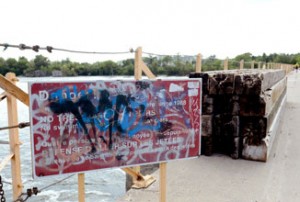Drownings lead to Trenton dam safety review
By Linda Horn

TRENTON ONTARIO (16/08/2011) A vandalized sign, on Dam 1 in Trenton, warning to stay people not to trespass on the dam. Dam 1 was the site of two drowings this past summer. Photo by Linda Horn
After two drownings this summer at Dam 1 in Trenton, local and federal officials are looking at what can be done to prevent future tragedies.
People have been swimming at the dam for years, and public officials say they are aware of the potential safety issues. In the wake of the two deaths this summer, officials are looking into ways to make the dam safer and re-educate the public about swimming there.
In the span of a month this summer, both 30-year-old Mike Almey and 16- year-old Cole Sager died while swimming at Dam 1. Almey went into the water from the shore and according to childhood friend Michelle Lemoire, he lost his footing and was swept away by the current.
Peter Valiquette, OPP Detachment Commander for Quinte West, said, “Mr. Sager passed away in the turbulent water after he jumped from the dam, while swimming with friends.
“There is a perception that swimming in and around the dam is acceptable because it has gone on for years. People need to take a real hard look at leisure activity in close proximity of the dam. The reality is people die,” said Valiquette.
According to Valiquette the OPP detachment in Quinte West is going to make a contribution to re-educate youth about swimming around dams.
“We are running the Ontario Power Generation commercial about being safe around dams at city hall. Our community service officer is also in talks with the local movie theatre to play that commercial before all the movies. We are also going to make dam safety a part of our curriculum to address to kids when we go into the schools,” said Valiquette.
Lemoire said, “It was a tradition to swim at the dam. I swam at the dam three times when I was 18. Once I saw someone struggle but managed to get out and I have never swam at the dam again. In my opinion, it is just not safe. The water changes so quickly.”
Aaron Drouillard, a Trenton resident, and another of Almey’s childhood friends, feels that swimming at the dam is safe when you know what you are doing.
“I felt it was safe because I knew what I was doing. When the water was high, you don’t swim. I found the current was not flowing as fast when the water was low,” said Drouillard.
Cody Sager, Cole Sager’s 14-year old cousin, has also swam at the dam.
“I felt comfortable and did not think it was dangerous. It does not really have warning signs.
“We had fun and thought nothing would happen. I started to find the water dirty and not liking it, so I stopped going,” said Sager.
The signs at Dam 1 have been graffitied over and difficult to read. The red signs on the front of the dam are only visible when you are off the dam and standing in front of it. Parts of the wire fence have been broken and instead of being replaced, they have been tied off to another part of the wire.
In comparison, a dam in Belleville has large red and yellow signs, which can be clearly seen and read. They warn people about turbulent water and tell them to stay away.
Quinte West Mayor John Williams said the waterway belongs to Parks Canada. He and Valiquette are going to meet with Parks Canada to discuss what can be done.
“Even though we don’t have jurisdiction, we want to make sure what is there is right.
We are going to look at signage, to see if they are the right signs and in the right spot,” said Williams.
Dawn Bronson, the Central Ontario field unit superintendent for Parks Canada, says it is looking into a number of dams along the waterway for priority dams to ensure public safety.
“Dam 1 is a priority dam,” said Bronson.
“Dam 1 is a very large dam and we need to make sure the public is safe. We work with our staff to discourage swimming and boating around dams. They are not safe places to swim or boat, ” said Bronson.
“We are looking at signage but have had a problem with graffiti in that area,” said Bronson.
Northumberland Quinte West Member of Parliament Rick Norlock agreed that all aspects of the dam will be looked at.
“When something is vandalized, should you replace it? Obviously you do,” said Norlock.
“The health and safety of our constituents is our number 1 concern. When people bring these things to our attention, we act on them,” said Norlock.
According to Valiquette, “Ultimately, we can’t stop people getting up to the dam but it is about creating an environment locally that deters people to the best of our collective ability. It becomes a generational thing like seatbelts. It is an ongoing effort to educate. Hopefully we’ll see fewer people thinking the risk is acceptable.”
 Print This Post
Print This Post






